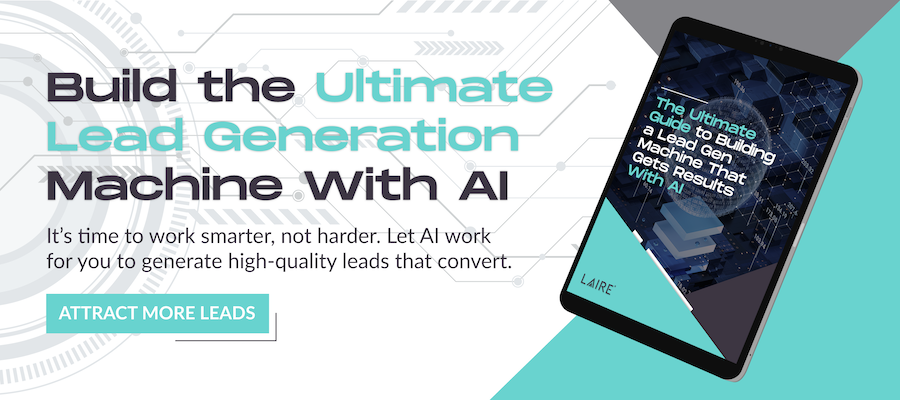High website traffic is great–but if that traffic isn’t driving conversions, it’s not helping your business grow. You’ll hear plenty of chatter about driving traffic to your website, but just as important is understanding how to translate that traffic into a high conversion rate. A low conversion rate could mean you’re not reaching your ideal target audience. Or, your website copy isn’t compelling enough to generate a conversion. Today, we’ll help you learn how to increase conversions on your B2B website and reach more potential clients.
What Is Conversion Rate?
The conversion rate is the percentage of users who take a desired action. These desired actions can include filling out a contact form, downloading an e-book or a PDF, or buying a product. You can calculate the conversion rate by taking the total number of completed actions or goals over a period of time and dividing that by the total number of visitors. For example, if you had 2,000 website visitors, but only 20 filled out a form, your conversion rate would be 1% (20 / 2,000 = .01, .01 x 100 = 1%).
How to Increase Your Conversion Rate
A low conversion rate is often a sign that your website isn’t performing as well as it should. The good news is that you can make various updates to your site that will improve user experience and ensure a clear path to a conversion.
1. Strong Calls to Action
Campaigns are often centered around CTAs (or, “calls to action”) for tracking goals and conversions. A strong CTA shows the significance between different links and catches the user's eye when scrolling down the page. CTAs are often one of the easiest design elements to change when optimizing your website. HubSpot provides CTA-tracking capabilities that simplify campaign linking, allowing for personalization for each user. HubSpot lets you personalize CTAs using details in your contacts database. You can also target anonymous visitors based on their location, device, referral source, or preferred language. This allows you to customize the user’s experience and move leads further down the funnel. Start by adding CTAs to your top-performing pages to begin collecting valuable data and ensure the chance of a conversion.
If you’re not utilizing buttons for your CTAs already, now is the time to change. Using buttons to differentiate your CTA from a regular link makes your offer stand out on the page with a 3D-like effect. You could also take this a step further and add a hover element to your buttons for an interactive feature.
While it’s great to have an eye-catching CTA on every page, you should still use them sparingly. If you use too many buttons or CTAs, you may end up with an over-complicated design that could confuse users and result in their not clicking anything at all. You want the user journey to average around three clicks from start to finish. By being selective with your positioning, you can clearly direct users, allowing them to reach their end goals faster–improving their overall experience on your site.
2. Skimmable Content
We all want to believe that our website visitors are going to read every sentence of website copy that we handcrafted for each page...but they’re not. Having a lot of content on your website is great for SEO, but you don’t want a site that’s hard for users to digest. Make sure you’re formatting your content to highlight key features of your goods or services.
Specifically, format your content to include the following:
- Strong headlines
- Short paragraphs
- Images
- Videos
- Bulleted lists
Incorporating different headers along with short paragraphs broken up by images or videos can help to simplify your content. This keeps the user from feeling overwhelmed by the content itself. As a matter of fact, posts with images get 94% more views than those without. Videos, infographics, and pictures help users process and retain information faster–keeping them engaged and more likely to convert.
3. Responsive Web Design
Web design and marketing are now firmly in “mobile first” territory–and your website needs to keep up. In 2021, 63% of Google’s visits in the US were via a mobile device. If your website is still not responsive for mobile devices, you could be missing out on half of your client base. More than 50% of mobile users will navigate away from a site if it takes more than three seconds to load. If your users still have to zoom in on the page to read your content or have to wait for your site to load, they are likely going to bounce and not convert. Ensuring you have a responsive web design can give users a smooth mobile experience on your site.
4. Testimonials and Reviews
When searching for B2B solutions, businesses are often looking for a partner that can provide them with reliable services and help them overcome their business problems. According to Demand Gen Report, 97% of B2B customers said that testimonials and peer recommendations were the content they trusted most. Customer testimonials and reviews on your B2B website can help you highlight your professionalism and expertise within the industry. Testimonials can be found in a variety of online directories and can make or break your online reputation. The more positive testimonials you obtain, the more credible your business will appear.
Try launching email campaigns to ask current customers for reviews or organize a shoot to create video testimonials. Another compelling way of highlighting reviews is in the form of a case study. Case studies can help you showcase compelling stats on how your clients have grown using your services or what benefits they received. Reviews can be used throughout all of your digital marketing efforts to boost your online reputation.
5. Simplify Your Form
Improving user experience goes hand in hand with increasing website conversions. Contact forms are often a big part of your goals and are frequently the ideal end result of the user journey. While filling out an online form may seem like a no-brainer, this is often a fairly big commitment to a user. Aim to simplify your forms by eliminating unnecessary fields, turning fields into checkboxes or other elements, and enabling autofill.
You want to ensure that there are no barriers for a user when filling out a form. Provide reassurance during this process. Use natural and conversational language–remember, users are often sharing private information, so make the process feel friendly and never intimidating.
6. Test Everything
The most important part of increasing conversions on your website or landing pages is to test different design elements, CTAs, and content to see what will work best for your target market. Monitoring your bounce rates and conversion rates will help you to understand what’s performing well and what needs to be updated. A/B testing–from landing page background images to form field lengths–can help you gather and analyze data to see what performs well and what doesn’t. Testing helps you strategize and gain valuable insight into what your customers want. Celebrated marketer and entrepreneur Neil Patel writes about how different companies used A/B testing to improve their website conversion rates in his blog post, “9 A/B Tests That You Can Run Tomorrow to Double Your Conversions.”
There are also a variety of screen-recording and heat-map tools to help you analyze how users are interacting with your website. Tools like HotJar can show you where your users are dropping off, as well as what elements they are clicking on the most.
By implementing these strategies, you can create a website optimization plan to drive traffic and increase your conversion rates. At LAIRE, we specialize in helping B2B businesses target their ideal users while optimizing and building a solid plan for increasing conversions and ROI. Contact us today to schedule a 20-minute marketing audit and learn how we can help you achieve your revenue goals.


